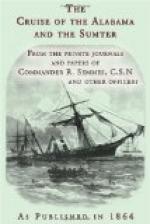Although to-day is the Sabbath—writes Captain Semmes, in his journal of the following day—I did not consider it any violation of Christian duty to continue coaling, as we are liable to be surprised at any moment, and to have our purpose defeated.
So, too, thought the Alabama’s crew, who worked cheerfully on throughout the day, completing their task by half-past eleven on the Monday morning. The Alabama had now on board about 285 tons, nearly 200 tons having been received from the Agrippina. Estimating her consumption at sixteen tons a day, which would give a moderate rate of steaming, she had, therefore, in her bunkers fuel for about eighteen days.
This important matter arranged, the next thing to be done was to send down the mainyard, which had been carried away in the cyclone, and roughly fished together, and to supply its place with the second new spar taken from the ship T.B. Wales. This occupied the greater portion of the 25th, and Captain Semmes then proceeded to “break out” the hold, for the purpose of taking stock of his provisions, no opportunity having yet offered, since the hurried shipment of stores off Terceira, to ascertain the precise amount in hand of salted provisions, and other necessaries. Batches of liberty-men were also sent on shore to recruit themselves with a run upon terra firma—an amusement in which such of the officers as could be spared were but too glad to join.
Wednesday, the 26th November, saw all these arrangements completed, and the last batch of liberty-men safely on board again after their run. The Alabama was now ready for a fresh cruise, but before taking leave of Blanquilla, there was an act of justice to be done. Accordingly, that afternoon a court-martial was summoned for the trial of George Forrest, the seaman who had originally deserted from the Sumter, and who, on his recapture, had been sentenced to serve out his time, forfeiting all pay, prize-money, &c. His present offence was that of endeavouring to incite the crew to mutiny, and of procuring with that object the liquor with which the rioters of the 18th November had been made intoxicated.
The case was clearly proved, and after some consultation judgment was passed, sentencing him to lose all prize-money, and to be dismissed the ship in disgrace. At a quarter past seven in the evening, all hands were mustered aft to hear the sentence read; and after a short but effective address from Captain Semmes, the prisoner was informed that he was now dismissed the Confederate service with the stain of infamy upon him, and bundled over the side into the boat that was to convey him to the shore.
This ceremony over, and the ship rid of the incorrigible scoundrel who had so long disgraced her, the men were dismissed, and preparations made for the Alabama’s departure. She had been already preceded by the Agrippina, three of whose hands had volunteered in exchange for three from the steamer, and on the return of the boat no time was lost in getting her under way. The captain and mate of the Yankee schooner were released, and the Alabama stood out to sea under easy sail.




